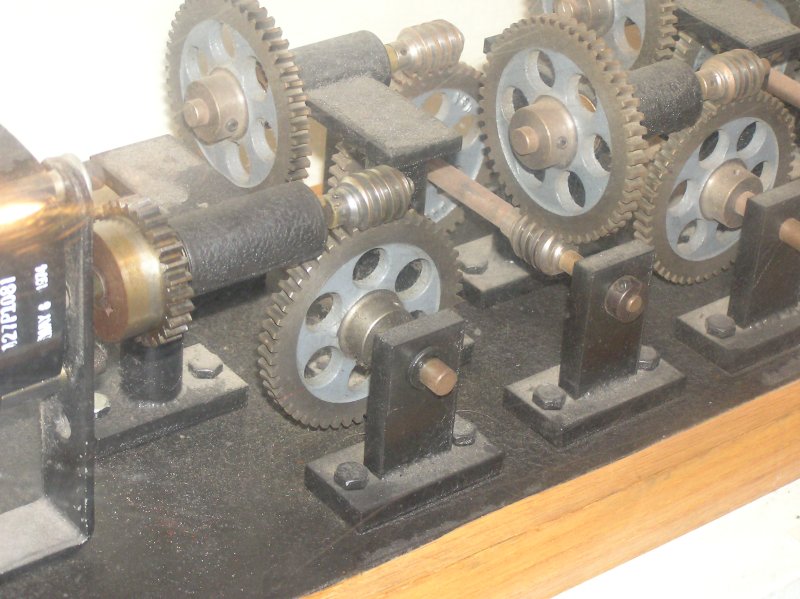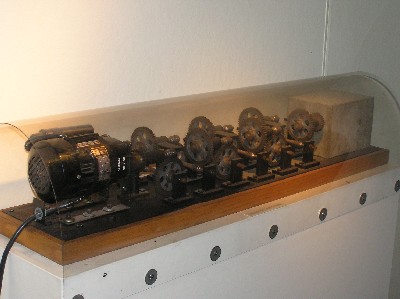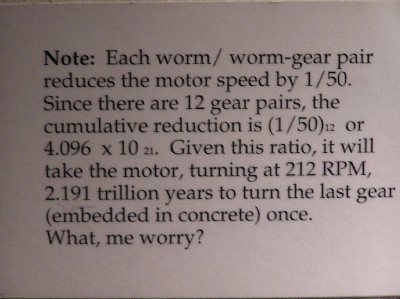
Answer to the Question 10/05
ROTATION REDUCTION
The question was:

The picture above shows a part of a mechanical contraption exhibited
in the main gallery of the MIT museum.
The contraption begins with a motor (on the left) turning at 212 revolutions per minute.
It is connected to a sequence of N worm-gears, that can be seen
in the picture. Each worm-gear pair reduces the rotation speed by
a factor of 50. The axle of the last gear in the sequence is
embedded in a concrete
wall and cannot rotate! Assuming that each gear consists of an axle of
about 10 cm in length and 1 cm in diameter, find the smallest N
for which such an arrangement is possible.
(2/06) This problem has been solved correctly (11/1/06) by
Dan Miller
(e-mail millerd10@t-one.net).
The answer: 8 gear pairs will probably suffice to keep the exhibit running for
a century or so. Either the motor or the exhibit or the building will cease
to exist by then... The actual contraption at MIT has 12 gear pairs.
The solution:
The solution of the problem relies on the existence of backlash (the play
between adjacent movable parts) between the gears. By assuming that the
last gear pair has a backlash of, say, 1/100 of the complete rotation
one can estimate how long will it take N gear pairs to create
such a rotation in the before-the-last gear. By assuming that
the contraption has to exist for few hundred years (or few billions
of years, as assumed by Miller) one can estimate the number or gears.
In the absence of backlash one would like to rely on elasticity
and estimate how much torque can be applied on the last gear before
it breaks. (This can be estimated from its dimensions, and the
knowledge of the material from which it is made.)
Here is what Miller actually wrote:
Let's assume that these gears are relatively finely machined, such that
the backlash at each gear is 1/100 of a revolution of the worm.
Let's also assume that the motor is solar powered, and that the solar cells,
motor, gears, bearings, etc will last forever.
BUT, our sun will only be around for ~1,000,000,000 years or so.
If the motor runs at 212 rpm for 1*109 years, it will rotate 1.1*1017 times.
Getting back to the backlash, the last worm needs to rotate 1/100 revolutions to "lock-up"
or break something. This means the previous worm must rotate 50/100 revolutions plus
its own back-lash or 0.51 revolutions. The next worm must rotate 50 * 0.51 revolutions or
25.5 revolutions plus its own backlash or 25.51 revolutions.
The backlash starts to become insignificant, and the motor revolutions required to take
the slop out of the system are ~5*1016 for 12 gear sets, or ~2.5*1018
for 13 gear sets.
With our solar life expectancy assumed to be 1.1*1017 revolutions of a 212 rpm
motor (or 1,000,000,000 years) then we can safely say that the sun will burn out prior to
the last shaft needing to rotate.
Now you can view the entire exhibit:

This is how MIT Museum explains its own exhibit.

 Back to "front page"
Back to "front page"




 Back to "front page"
Back to "front page"